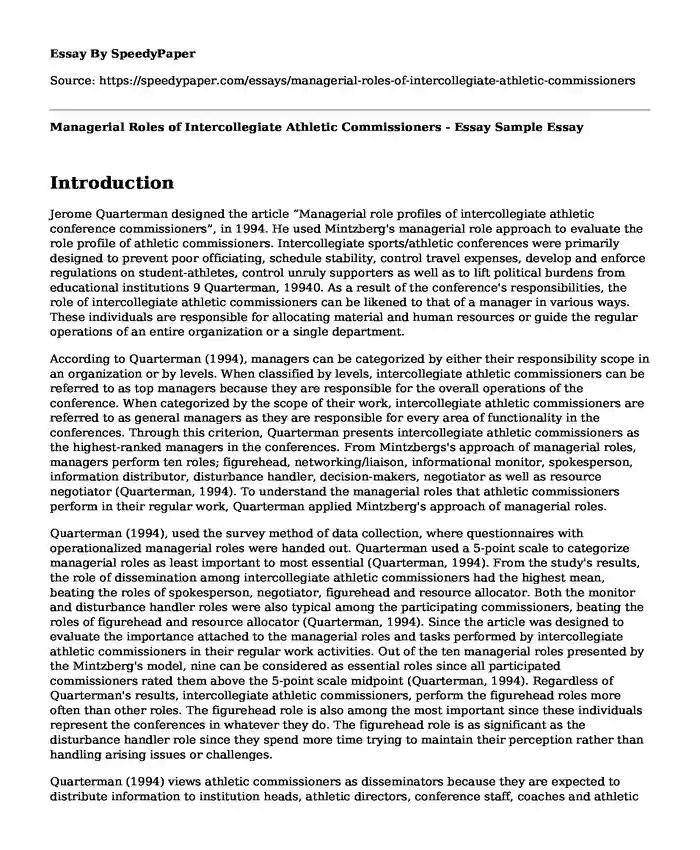
| Type of paper: | Essay |
| Categories: | Management Sport |
| Pages: | 4 |
| Wordcount: | 843 words |
Introduction
Jerome Quarterman designed the article “Managerial role profiles of intercollegiate athletic conference commissioners”, in 1994. He used Mintzberg's managerial role approach to evaluate the role profile of athletic commissioners. Intercollegiate sports/athletic conferences were primarily designed to prevent poor officiating, schedule stability, control travel expenses, develop and enforce regulations on student-athletes, control unruly supporters as well as to lift political burdens from educational institutions 9 Quarterman, 19940. As a result of the conference's responsibilities, the role of intercollegiate athletic commissioners can be likened to that of a manager in various ways. These individuals are responsible for allocating material and human resources or guide the regular operations of an entire organization or a single department.
According to Quarterman (1994), managers can be categorized by either their responsibility scope in an organization or by levels. When classified by levels, intercollegiate athletic commissioners can be referred to as top managers because they are responsible for the overall operations of the conference. When categorized by the scope of their work, intercollegiate athletic commissioners are referred to as general managers as they are responsible for every area of functionality in the conferences. Through this criterion, Quarterman presents intercollegiate athletic commissioners as the highest-ranked managers in the conferences. From Mintzbergs's approach of managerial roles, managers perform ten roles; figurehead, networking/liaison, informational monitor, spokesperson, information distributor, disturbance handler, decision-makers, negotiator as well as resource negotiator (Quarterman, 1994). To understand the managerial roles that athletic commissioners perform in their regular work, Quarterman applied Mintzberg's approach of managerial roles.
Quarterman (1994), used the survey method of data collection, where questionnaires with operationalized managerial roles were handed out. Quarterman used a 5-point scale to categorize managerial roles as least important to most essential (Quarterman, 1994). From the study's results, the role of dissemination among intercollegiate athletic commissioners had the highest mean, beating the roles of spokesperson, negotiator, figurehead and resource allocator. Both the monitor and disturbance handler roles were also typical among the participating commissioners, beating the roles of figurehead and resource allocator (Quarterman, 1994). Since the article was designed to evaluate the importance attached to the managerial roles and tasks performed by intercollegiate athletic commissioners in their regular work activities. Out of the ten managerial roles presented by the Mintzberg's model, nine can be considered as essential roles since all participated commissioners rated them above the 5-point scale midpoint (Quarterman, 1994). Regardless of Quarterman's results, intercollegiate athletic commissioners, perform the figurehead roles more often than other roles. The figurehead role is also among the most important since these individuals represent the conferences in whatever they do. The figurehead role is as significant as the disturbance handler role since they spend more time trying to maintain their perception rather than handling arising issues or challenges.
Quarterman (1994) views athletic commissioners as disseminators because they are expected to distribute information to institution heads, athletic directors, conference staff, coaches and athletic representatives. The dissemination role of athletic commissioners is categorized as the most significant since information dissemination allows conference staff and other stakeholders to stay updated on any changes (Quarterman, 1994). In business settings, the role of information distribution is significant among first-level managers. The disseminator role is vital to athletic managers since miscommunication can directly jeopardize conference activities.
The role of networking and liaising was among the most significant as the majority of commissioners believed in the power of contact with organizations and people not directly involved in the conference. According to Quarterman (1994), developing outside contacts allowed commissioners to act as the links between the conference and other organizations. Having critical networks and contacts out of conference who either influence the leader directly or indirectly is essential for athletic commissioners. The roles of disturbance handler and monitor are also portrayed as vital by the study. This is because, with the growing pressure to win games, athletic commissioners must address unexpected issues that are raised in the conference. They also act as radar units, where they regularly scan and probe the environment for new information and insights (Quarterman, 1994). As leaders, athletic commissioners are responsible for influencing their junior employees in completing their tasks and meeting targets.
Instructors to make relevant decisions in sports management and administration programs can apply the article. Line administrators who are tasked with recruitment and selection activities can as well use them. (Quarterman, 1994)
Conclusion
In conclusion, Quarterman's article on Mintzberg's managerial role profiles of college athletic commissioners justify that they are mangers. The disseminator role of management among athletic commissioners is the most significant. The roles of liaison, monitoring and disturbance handler are also significant since they emphasize the benefits of networking, inspection as well as addressing unexpected issues in the conference. Mintzberg's approach of managerial roles can be used to explain the different roles played by leaders of businesses or organizations in their daily activities. The different roles performed by managers as portrayed by this article can as well be used to understand the importance of managers in an organization.
References
Quarterman, J. (1994). Managerial role profiles of intercollegiate athletic conference commissioners. Journal of Sport Management, 8(2), 129-139. https://journals.humankinetics.com/view/journals/jsm/8/2/article-p129.xml
Cite this page
Managerial Roles of Intercollegiate Athletic Commissioners - Essay Sample. (2023, Dec 30). Retrieved from https://speedypaper.net/essays/managerial-roles-of-intercollegiate-athletic-commissioners
Request Removal
If you are the original author of this essay and no longer wish to have it published on the SpeedyPaper website, please click below to request its removal:
- Sociocultural Foundation of Sports and Recreation, Free Essay Example
- Global Perspectives in Managing People - Essay Example for Students
- Stress and Stress Management - Research Paper Example
- Essay Example: Hospitality Industry Career Opportunities
- Free Essay. How Long Do You Typically Wait to Be Seated?
- Essay Example: Reflection on Stress in the Workplace
- Free Paper Sample: Contemporary Issues in Project Management
Popular categories




